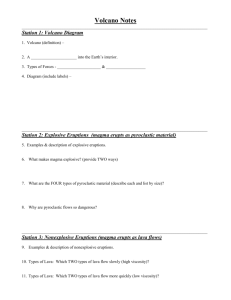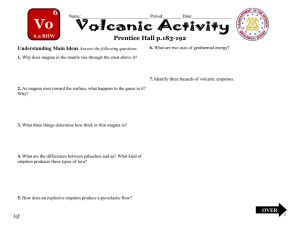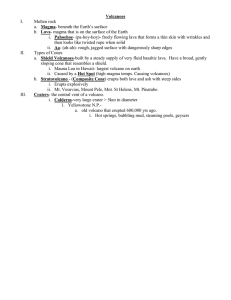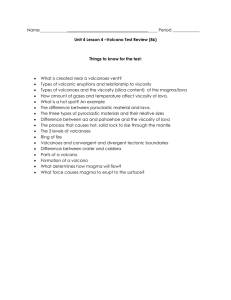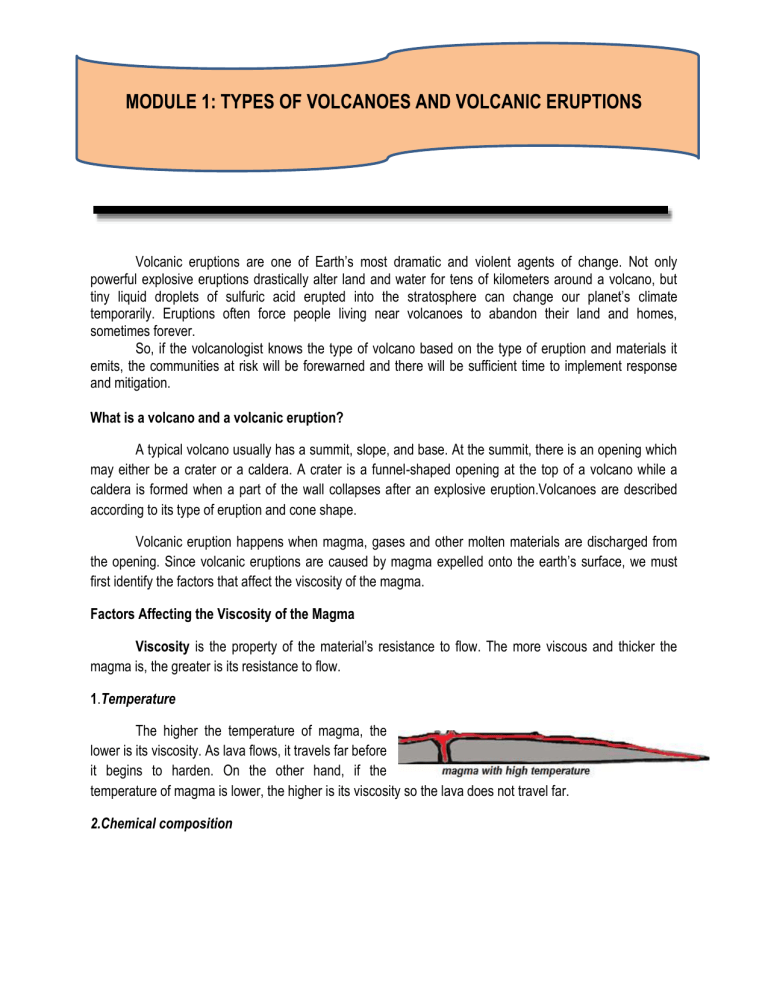
MODULE 1: TYPES OF VOLCANOES AND VOLCANIC ERUPTIONS Volcanic eruptions are one of Earth’s most dramatic and violent agents of change. Not only powerful explosive eruptions drastically alter land and water for tens of kilometers around a volcano, but tiny liquid droplets of sulfuric acid erupted into the stratosphere can change our planet’s climate temporarily. Eruptions often force people living near volcanoes to abandon their land and homes, sometimes forever. So, if the volcanologist knows the type of volcano based on the type of eruption and materials it emits, the communities at risk will be forewarned and there will be sufficient time to implement response and mitigation. What is a volcano and a volcanic eruption? A typical volcano usually has a summit, slope, and base. At the summit, there is an opening which may either be a crater or a caldera. A crater is a funnel-shaped opening at the top of a volcano while a caldera is formed when a part of the wall collapses after an explosive eruption.Volcanoes are described according to its type of eruption and cone shape. Volcanic eruption happens when magma, gases and other molten materials are discharged from the opening. Since volcanic eruptions are caused by magma expelled onto the earth’s surface, we must first identify the factors that affect the viscosity of the magma. Factors Affecting the Viscosity of the Magma Viscosity is the property of the material’s resistance to flow. The more viscous and thicker the magma is, the greater is its resistance to flow. 1.Temperature The higher the temperature of magma, the lower is its viscosity. As lava flows, it travels far before it begins to harden. On the other hand, if the temperature of magma is lower, the higher is its viscosity so the lava does not travel far. 2.Chemical composition Magma with high silica content is more viscous than those with low silica content. It is too viscous so it does not travel far, and tends tobreak up as it flows. The magma that contains less silica is relatively fluid, so it travels far before solidifying. 3. Amount of dissolved gases it contains. Whenmagma has high amount of gas (mainly water vapor), lava flow is less viscous and increases its ability to flow. Magmahas high viscosity when it has low amount of gas as it rises. The ability of the lava to flow decreases, soit piles up at a vent resulting into a columnar or a dome. Types of Volcanoes After a volcanic eruption, a cone-shaped structure may be produced. Its slope also changes.The following are the three (3) general types of volcanoes according to the shape of their cones: Shield volcanoes are formed by the pileup of nonviscous lava that oozes out from the volcano. Since lava can flow freely, a broad, slightly domed structure is formed that resembles like a warrior’s shield. Mauna Loa Volcano in Hawaii is an example of this type. Composite volcanoes are formed due to alternating solidification of both lava and pyroclastic deposits which makes it nearly a perfect sloped structure. Pyroclastic flows occur when these volcanoes erupt. Mount Saint Helens in Washington, Mt. Vesuvius in Italy and Mt. Mayon in the Philippines are examples of this type. Cinder cones are formed from alternating ejected lava fragments andash. They have a steep slope, wide crater on top and are the most abundant of the three major volcano types. Although small, they are also destructive since they release high amounts of pyroclastic materials. Mt. Paricutin in Mexico which has erupted in 1943, Taal Volcano in Batangas are examples of this type. Types of Volcanic Eruptions Volcanoes erupt differently and not all of them are violent. Magma can explode from the vent, or it can flow out of the volcano. In addition to the top vent, magma and gas may escape through cracks and weak areas on the sides of the volcano. Aside from lava, pyroclastic flows, ash clouds and mudflows(lahar) can be extremely dangerous. The levels of silica and dissolved gases in the magma determine whether a volcano erupts explosively or not. a. Phreatic or hydrothermal – is a steam-blast small eruption as hot rocks heat the ground water or surface water. This eruptiontears down surrounding rocks and can produce ash columns, but do not include new magma. Taal Volcano which erupted last January 12, 2020 is an example of this type. b. Phreatomagmatic - a violent and explosive eruption resulting from the interaction of new magma or lava with water. It results to a large column of very fine ash, high-speed and sideway emission of pyroclastics. c. Strombolian- least violent type of explosive eruption characterized by a fountain of lava fragments. Eruptions are weak to a little more violent which has thicker lava flows and small explosions. d. Vulcanian - small to moderate explosive eruptions characterized by tall columns that reach up to 20km high with pyroclastic flow and ashfall tephra. They have larger explosions of rocks and ashes which rise in dark clouds lasting for seconds to minutes. Paricutin Volcano eruption in Mexico is an example of this type. e. Plinian - excessively explosive type of eruption of gas and pyroclastics like that of Mount Pinatubo eruption in 1991. The explosive eruptions, lasting for seconds to minutes have 20 to 35 km tall gas, rock particles and ash columns. MODULE 2: VOLCANIC ERUPTION What Happen When Volcanoes Erupt Volcanic eruption refers to the release of magma from a volcano. The term “magma” refers to the molten materials that are still inside the volcano. When these molten materials are being ejected or reached into the surface, it is then called “lava”. When volcanoes erupt it ejects different materials into the Earth’s surface; It releases lava, which is made of molten materials that reach the surface of the earth. Lava contains different elements and compounds. One of the compounds it contains is Silica or chemically known as silicon dioxide which greatly influences the lava’s viscosity. Thesilica content of the lava determines the volcano’s explosiveness. Lava also contains useful elements like potassium and phosphorus which has a positive effect in farming because it promotes soil fertility. In any type volcanic eruption, may it be violent or not, volcanoes release smoke. The smoke is a mix of different gases like water vapor, carbon dioxide, sulfur dioxide, and hydrogen sulphide. These gases that are ejected during volcanic eruptions have influences on climate. sulfur dioxide can cause global cooling and carbon dioxide can cause an increase in the atmospheric temperature contributing to global warming. Aside from smoke, volcanoes also release volcanic ashreferred to as “ tephra” which are made of tiny fragments of rock and minerals. In some huge volcanic eruptions, volcanic ash fall may cause the decrease in the Earth’s average temperature for a few years. How do volcanic eruptions affect the society? It can have a devastating effect on people and the environment. However, unlike earthquakes, volcanoes can also have a positive impact on an area. These positive impacts can help to explain why people choose to live near volcanoes. Advantages and Disadvantages of Volcanic Eruption Raw material Volcanic material can be made in to blocks for construction purposes. People became creative also by making pots out of the ashfall from the volcanic eruption.

